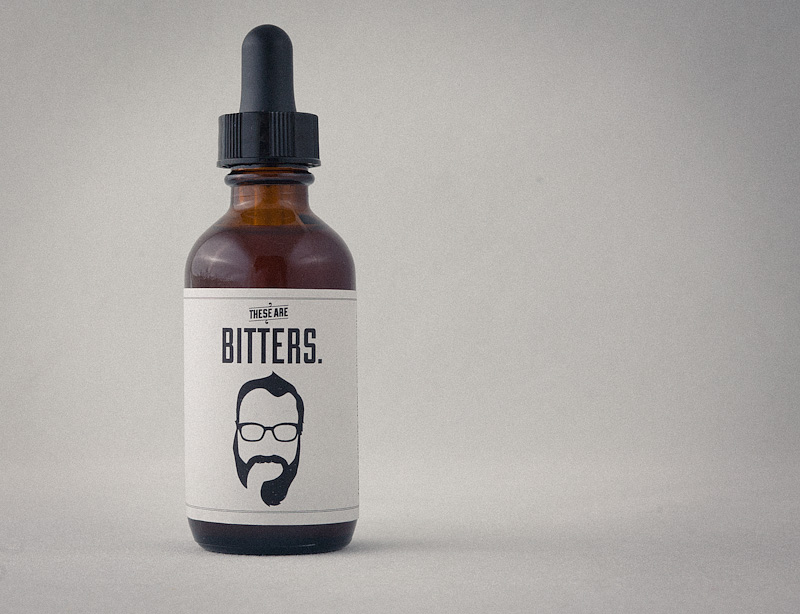
This is a little different for me, but: several months back, I was at Haven in Oakland for dinner with some friends. One of them ordered an Old Fashioned that contained “Mole Bitters”. The Old-Fashioned is my favorite cocktail, for annoyingly-predictable reasons: done properly, it requires some care and attention from the bartender. It seems like good bartenders get a little excited when someone orders one from them. Several times I’ve been asked “Can I make it for you with X?” or “Do you prefer bourbons that are spicy or sweet?” or things like that. To me, this is a sign that I’m gonna get something delicious. If the bartender reaches for a cocktail handbook to look up how to make one, I usually backtrack and get a beer.
I’m a pretty avid advocate of “Drinking makes you perform better”, be it at darts, pool, or cooking. Smoking some BBQ just seems wrong unless some bourbon is being poured. I like messing around with my Old Fashioned at home. Last time I made bbq, I threw an orange into the smoker for a half hour, then used the peel in my drink. I can’t recommend this highly enough. The Alinea stuff also involves making lots of funky syrups and sweet things; passionfruit syrup, licorice syrup, fennel syrup, etc. I usually keep small squirt bottles of these in the fridge and try them out in an Old Fashioned in place of the traditional sugar cube or simple syrup, with varying results.
The one ingredient it never really occurred to me to play with was the bitters. I have obligatory bottles of Angostura, Peychaud’s, and Regan’s, but never really found them to be anything more than “Oh, and yeah, I gotta add some of THIS weird stuff…”. The Mole Old Fashioned, then, was pretty eye-opening for me. I thought chocolate and bourbon sounded particularly bad, and in fact it’s exactly the opposite. It was amazing.
Anyway, I came home with an itch to learn a bit more about bitters.
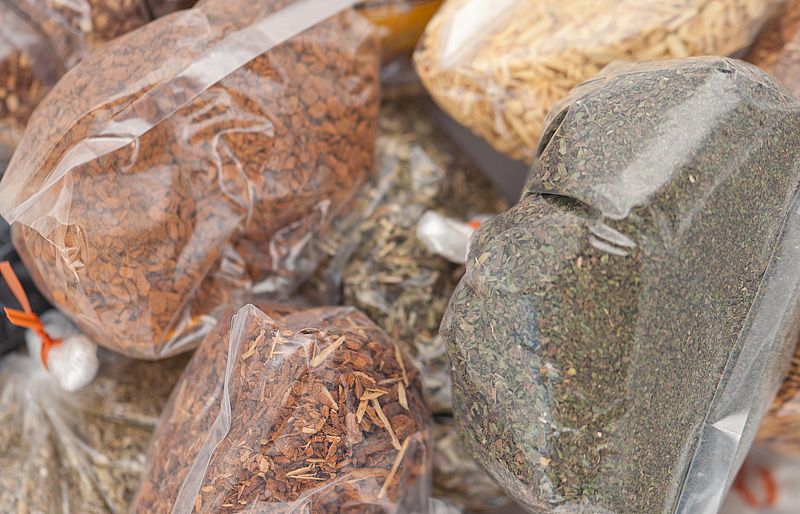
Bitters have historical roots in medicine; they were originally used to treat stomach disorders like indigestion or nausea long ago. It’s easy to see how the whole “Step right up for a sip of Dr. Whoosit’s Ultra-Healing Never-Fail Instant Cure-All!” snake oil traveling salesman thing sprung up as an offshoot from legitimate medicinal bitters, which were derived from root barks and a host of other herbs and spices and usually tasted pretty rough. Eventually one bitters remedy, Angostura, found a foothold when it was exported from Venezuela to England and was used by the Royal Navy to ‘simulate or settle the stomach before a meal or a cocktail’…in other words, a couple dashes of Angostura Bitters was sort of like pounding Advil the night of a good bender to avoid a hangover the next day.
The habitual adding of Angostura to cocktails gave rise to the widespread use of cocktails bitters, and several interesting varieties were introduced. This lasted until Prohibition, which more or less killed the entire bitters market. Only Angostura was able to weather that storm. Nowadays, bitters are undergoing a resurgence in popularity as a cocktail garnish. The Mole Bitters are one example; there are heaps of other varieties.
A bit of googling around yielded several resources that described the basic framework behind making ones own bitters.
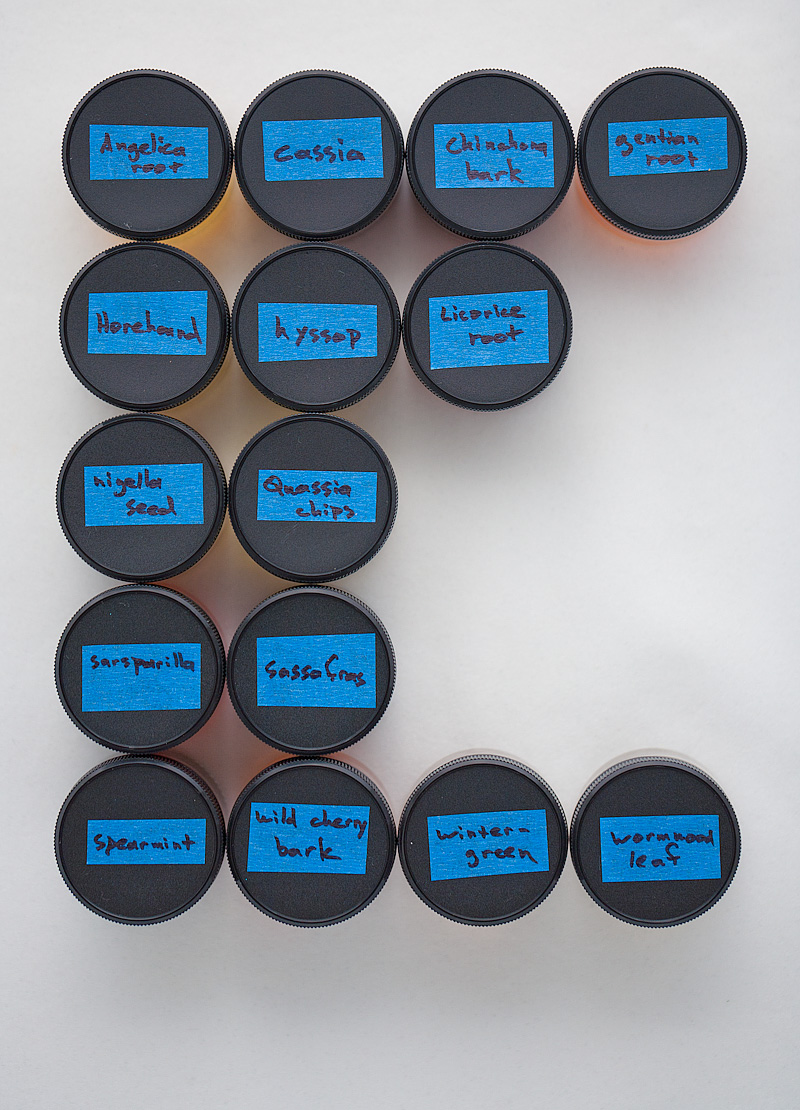
Bitters are an alcoholic infusion of one or more bittering agents (hence the name), one or more aromatic elements, and some sweetness. Like cinnamon or vanilla, bitters tend not to have much of ‘taste’ in and of themselves (for proof: try chewing on a cinnamon stick or a vanilla bean…they’re both largely flavorless/gross. It’s the aroma that’s doing all the work, and in the absence of sugar or some other form of sweetness, these two aromatics–and many others–are almost unrecognizable); it’s the aromatics that do most of the work. It’s easy enough to find recipes with pre-measured collections of infusion ingredients that you chuck in a jar with some high-proof alcohol and let sit for a few weeks; strain out the solids and you have bitters. The downside with this all-in-one approach is lack of control; if I don’t like the contribution of one ingredient or another, I have to start all over to rebalance.
A better (but more difficult) approach is infusing each ingredient separately, then combining each tincture (infusion) to yield the desired result.
To start teaching myself, I bought a book about making bitters. In it are a handful of recipes that describe the same basic all-in-one framework. More-interesting to me than the recipes were the individual ingredients themselves. Bitters are made from a variety of things, many of which I’d never heard of. I made a list of every unfamiliar ingredient in the entire book, then went shopping at an herbal remedy store in Berkeley to buy as many of them as I could. I also bought a couple dozen small 2oz jars, and filled each jar with an ounce of Everclear grain alcohol and a 1 tbsp of each herb or root. I let each of these infuse for a week, then strained the liquids. I tasted and smelled each of them, making a list of various adjectives that came to mind. This was both interesting and really hard; it was challenging to try to describe an unfamiliar taste or aroma without having any context for it. Some tinctures were grassy, woodsy, or haylike; many were very bitter, some had herbal notes.
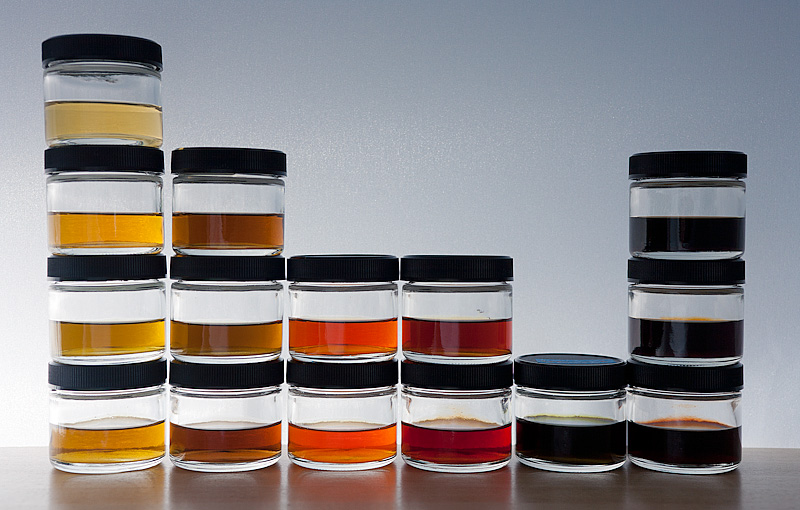
A trick mentioned in the bitters book: when getting an impression of an aromatic, alcohol-based infusion, apply a few drops to your palm, rub your hands together to release the scent, then inhale deeply. A drawback I found from using Everclear: it’s very, very alcoholic. The fumes from the ethanol were overpowering in many cases, masking the subtle notes of whatever I’d infused it with. I had to add a splash of water to some samples. This was also fascinating, and is why some brown-liquor purists like to add an ice cube or a splash of water to ‘open up’ their bourbon or scotch–the water dilutes the alcohol, allowing more-subtle notes to come forward. Finding the right concentration of alcohol would be a balancing act.
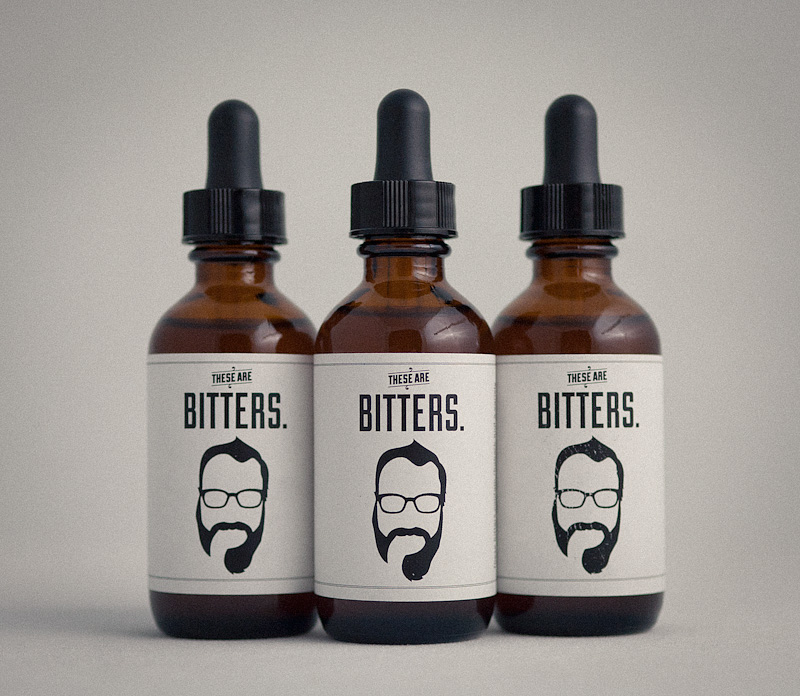
After several months of messing around with it, I’ve got a few first batches here that are somewhat-usable I think. I leveraged what I learned from the Beef, Elements of Root Beer dish to make my own Root Beer Bitters. A recipe my brother-in-law sent me for rhubarb-cherry BBQ sauce (OMGOMG) and the big Rhubarb-based Alinea dish I made a couple years ago made me want to try making a Rhubarb Bitters. And my general love of Old-Fashioneds, southern food, and being loud and unsubtle led to a batch of Coffee-Pecan bitters. Each of these had barebones roots in the Bitters book I mentioned above, but I took the different tack of trying to infuse everything independently and balance the final combination because it made more sense to me.

The first batch–Root Beer Bitters–used Everclear again. I found what I needed to do after infusing the Everclear was thin it with water to ease off the alcohol fumes. This means diluting flavor though, so to try to help, I took the solids that had been sitting in the Everclear and threw them in a pot with some water, boiled to make a tea, and used that. This kinda-sorta worked, but I think the better thing would be to either start with a lower-proof alcohol (to omit the need to dilute) or make the tea with fresh ingredients (for more flavor). The bitters taste and smell nice, but aren’t as “WHOA!” as I want them to be.
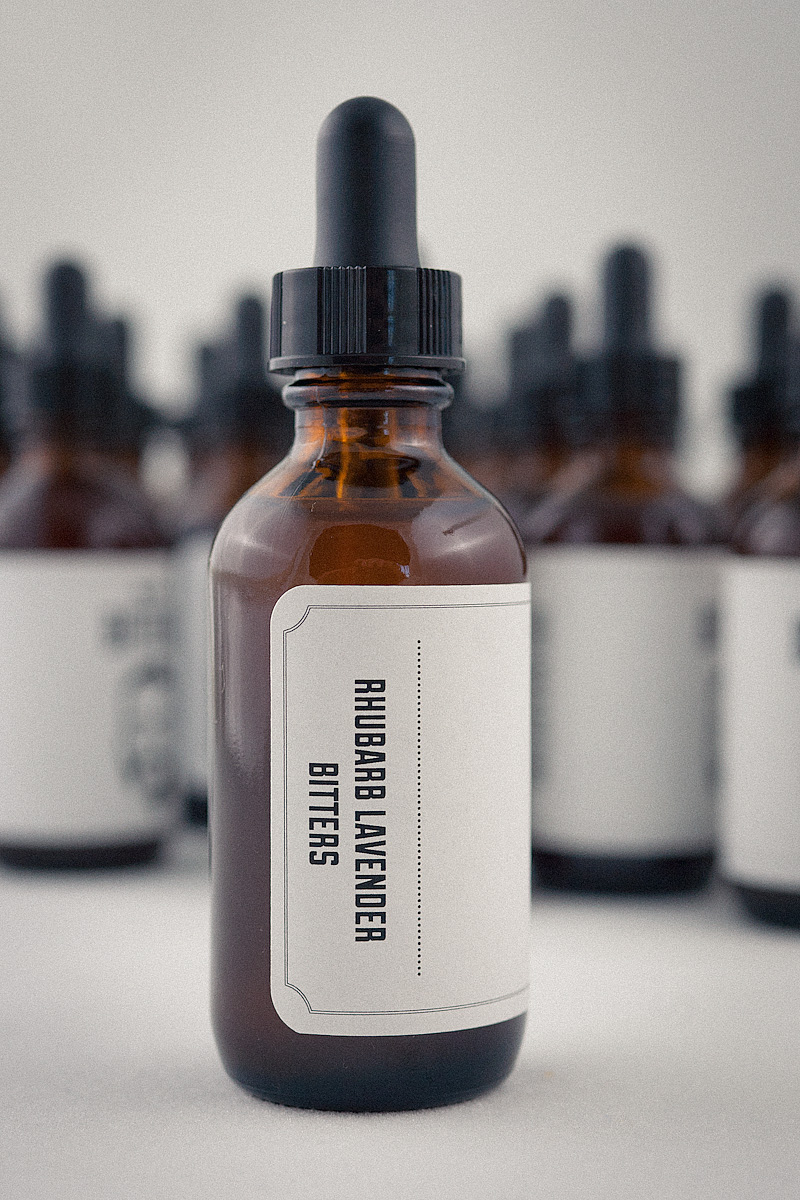
The next one I tried was the Rhubarb one; this worked better, but I found that infusing rhubarb doesn’t yield something that has that tartness you’d expect from it…it turns into something way more subtle. I found a reference from one bitters-maker mentioning the use of hibiscus; this would add a bit of bright tartness and more-vibrant color that I think would be nice. Theoretically, because I’d infused everything independently, I could just infuse some alcohol with hibiscus and add that in, but I’d already started the decanting process by the time I came across this tip.
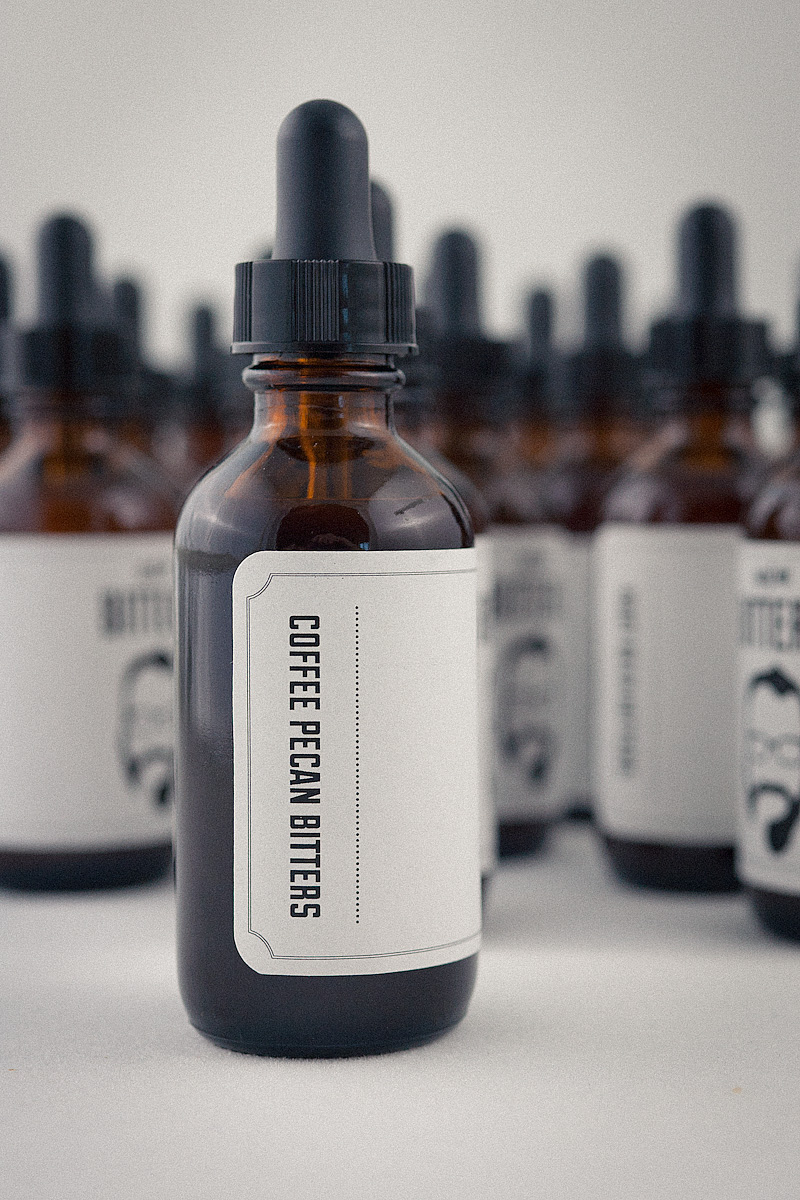
The Coffee-Pecan ones are my favorite. They’re loud and obvious and I totally love them. My only regret is not making a bigger batch, but that’s easy enough to fix. I’ve also come across several recipes that mention ageing bitters in a wood barrel after combining, to round out the complexity. I think this’d be how I’d “plus out” these bitters.
The bottles can be bought online–I found mine at “Specialty Bottle”, which is a fun site to poke around. The labels were courtesy of Sarah, of course.
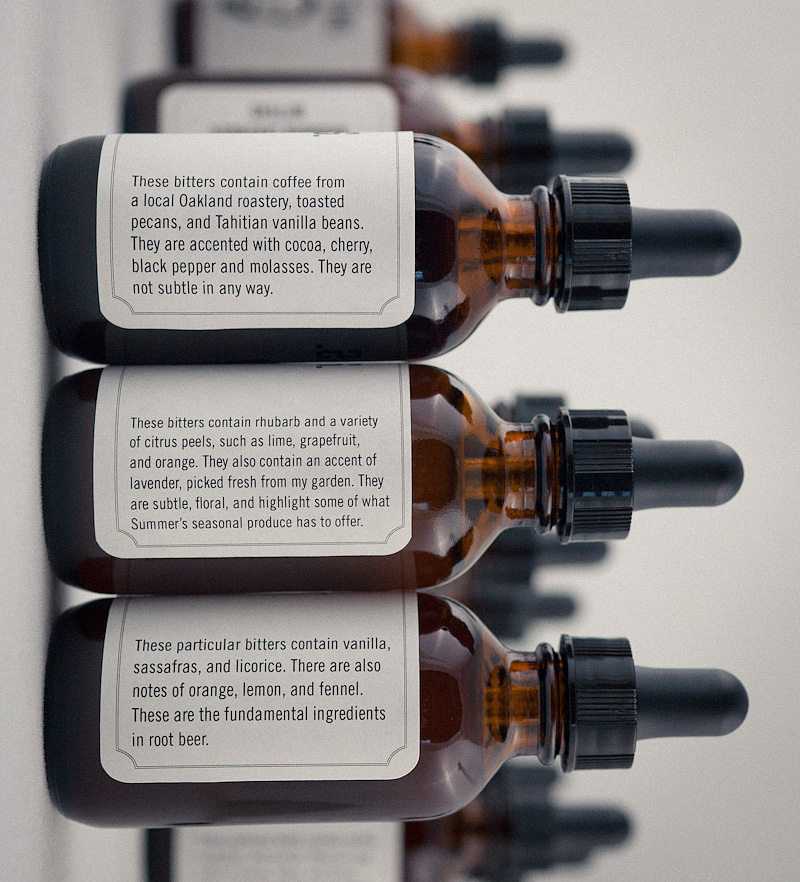
Each batch was only about 1L or so, so pretty small. Once I get the hang of this a bit better, I’ll try making larger batches…the better to distribute widely amongst friends.
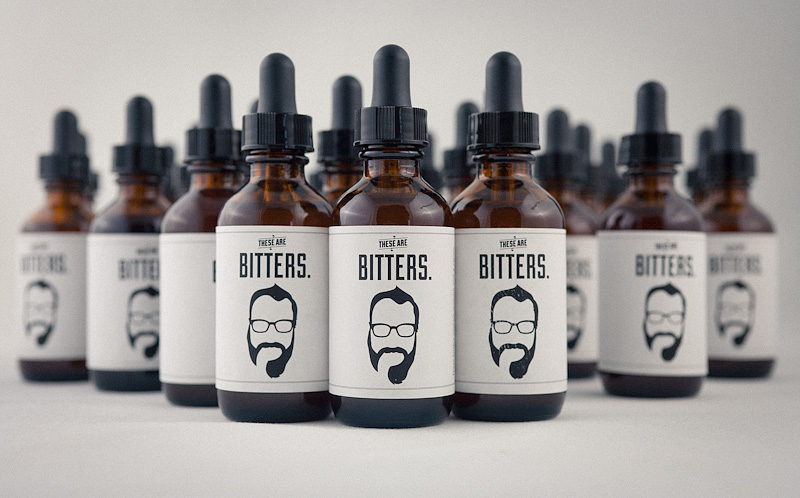
Ha! Wow. These look and sound terrific. Have fun drinking them all.
Friend pointed me to your site because he said this post reminded him of me.
I have so many bottles of bitters I don’t even know what to do with them.
I’ll assume you’re the same.
If you care to ever trade batches I live in the bay too.
Hey Matt; that’s awesome! I might be brave enough to foist some of these on others after a few more batches, but at that point doing some trading would be cool!
So, being a lover of the old fashioned myself, i am now *exceptionally* jealous of your bitter making skillz. While i have had some variations on the theme, i find myself still turning to my favorite iteration: 1 1/2 jiggers bourbon added to two bourboned cherries which have been muddled thoroughly with two sugar cubes (those sugar cubes soaked in angustura or fentiman’s aged bitters). Add a squeeze of a sixth of an orange and an eighth of a lemon. Pour over a 2″ square ice cube and serve with a stemmed bourbon cherry. But what i want to try now is rhubarb bitters instead.
Incidentally, i find that the best mojitos also have some bitters added, and i make a pretty mean drink with Snap liquor, aged whiskey barrel aged bitters and orange pelegrino soda. It’s surprising how delicious (and fancy pants) they can be even in a daily N/A drink like ginger beer.